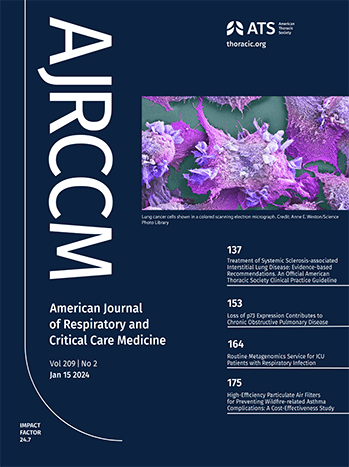icu后远程医疗模式(WFIT)的随机对照试验
IF 19.4
1区 医学
Q1 CRITICAL CARE MEDICINE
American journal of respiratory and critical care medicine
Pub Date : 2025-06-18
DOI:10.1164/rccm.202411-2167oc
引用次数: 0
摘要
危重疾病的幸存者长期预后不佳的风险很高,包括再入院、生活质量下降和死亡率。icu后远程医疗模式可以改善结果。目的:评估icu后远程医疗模式的成本效益和临床疗效。方法我们对400例脓毒症和/或急性呼吸衰竭ICU患者进行了单中心随机对照试验,这些患者在过去一年中住院≤2次,未从临终关怀医院、专业护理机构或长期急性护理医院住院或出院。干预组在icu出院后1周和2周安排远程医疗访问,并根据需要与经过icu后康复培训的临床医生进行为期6个月的远程医疗访问。主要结果是干预的成本效益。测量和主要结果在急诊室就诊和住院的总体医疗保健支出中,注意对照组的平均(SD,以美元计)为7,801.10美元(15,461.03美元),干预组的平均(SD,以美元计)为8,086.50美元(17,464.87美元),计算出的净收益增量为1,958.29美元(- 5,779.56美元,9,696.14美元)。两组之间到我们医疗保健系统就诊的次数相同,但患者报告的到外部医院就诊的次数不同(注意对照组每月每100名患者就诊0.97次,干预组每月2.43次,p=0.03)。两组患者的再入院率、死亡率、生活质量评分和总体患者满意度评分相似。结论:与标准护理相比,icu后远程医疗干预的随机对照试验显示了广泛的差异,但没有明显的增量净收益。本文章由计算机程序翻译,如有差异,请以英文原文为准。
A Randomized Controlled Trial of a Post-ICU Telehealth Care Model (WFIT).
RATIONALE
Survivors of critical illness are at high risk for poor long-term outcomes including readmissions, reduced quality of life, and mortality. A post-ICU telehealth care model may improve outcomes.
OBJECTIVES
We sought to evaluate the cost-effectiveness and clinical efficacy of a post-ICU telehealth care model.
METHODS
We performed a single center randomized controlled trial of 400 ICU patients with sepsis and/or acute respiratory failure, who had ≤2 hospital admissions in the past year, and who were not admitted from or discharged to hospice, a skilled nursing facility or a long-term acute care hospital. The intervention group had scheduled telehealth visits at 1- and 2- weeks post-ICU discharge and as needed for six months with a clinician trained in post-ICU recovery. The primary outcome is cost-effectiveness of the intervention.
MEASUREMENTS AND MAIN RESULTS
Overall healthcare spending on ER visits and hospitalizations were a mean (SD, in USD) $7,801.10 (15,461.03) in the attention control group vs 8,086.50 (17,464.87) in the intervention group, with a calculated incremental net benefit of $1,958.29 (-$5,779.56, $9,696.14). ER visits to our health care system were the same between groups, but patient-reported ER visits to outside hospitals were different (0.97 per 100 patients per month in the attention control group vs 2.43 in the intervention group, p=0.03). Readmissions, mortality, quality of life scores and overall patient satisfaction scores were similar between groups.
CONCLUSIONS
This randomized controlled trial of a post-ICU telehealth intervention demonstrated wide variation, but no clear incremental net benefit compared to standard care.
求助全文
通过发布文献求助,成功后即可免费获取论文全文。
去求助
来源期刊
CiteScore
27.30
自引率
4.50%
发文量
1313
审稿时长
3-6 weeks
期刊介绍:
The American Journal of Respiratory and Critical Care Medicine focuses on human biology and disease, as well as animal studies that contribute to the understanding of pathophysiology and treatment of diseases that affect the respiratory system and critically ill patients. Papers that are solely or predominantly based in cell and molecular biology are published in the companion journal, the American Journal of Respiratory Cell and Molecular Biology. The Journal also seeks to publish clinical trials and outstanding review articles on areas of interest in several forms. The State-of-the-Art review is a treatise usually covering a broad field that brings bench research to the bedside. Shorter reviews are published as Critical Care Perspectives or Pulmonary Perspectives. These are generally focused on a more limited area and advance a concerted opinion about care for a specific process. Concise Clinical Reviews provide an evidence-based synthesis of the literature pertaining to topics of fundamental importance to the practice of pulmonary, critical care, and sleep medicine. Images providing advances or unusual contributions to the field are published as Images in Pulmonary, Critical Care, Sleep Medicine and the Sciences.
A recent trend and future direction of the Journal has been to include debates of a topical nature on issues of importance in pulmonary and critical care medicine and to the membership of the American Thoracic Society. Other recent changes have included encompassing works from the field of critical care medicine and the extension of the editorial governing of journal policy to colleagues outside of the United States of America. The focus and direction of the Journal is to establish an international forum for state-of-the-art respiratory and critical care medicine.

 求助内容:
求助内容: 应助结果提醒方式:
应助结果提醒方式:


